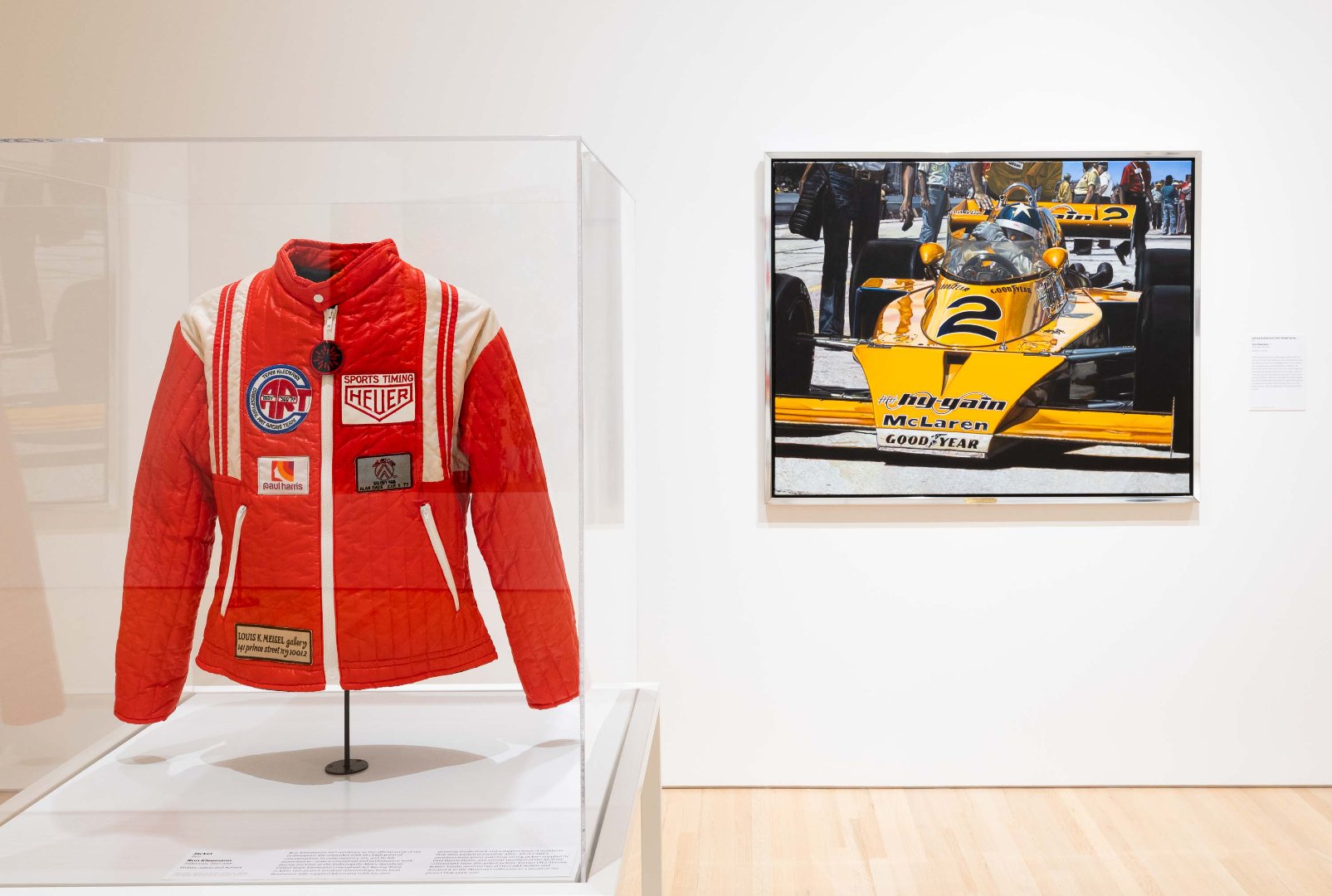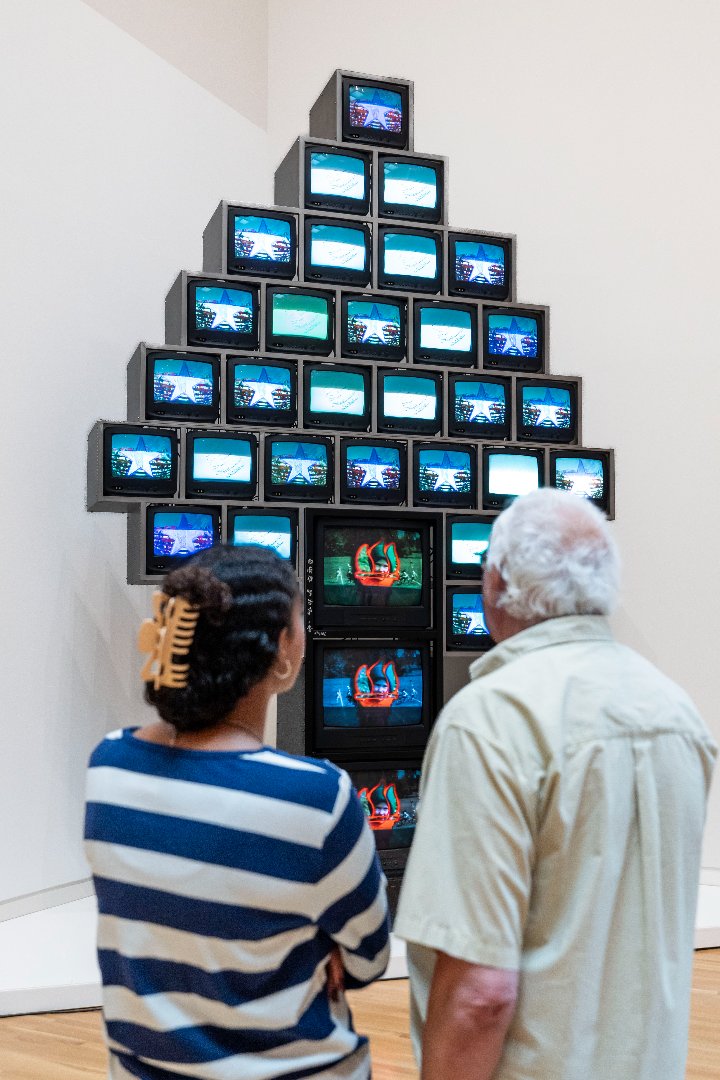The Message is the Medium: A New View of the Contemporary Collection
The Message is the Medium: Contemporary Art was conceived as a showcase for the Indianapolis Museum of Art’s permanent collection of contemporary art to celebrate its long-awaited return to the museum. While this reinstallation includes visitor favorites from Floor 4 including Tara Donovan’s Untitled (Mylar) and James Turrell’s Acton, I didn’t want to simply recreate those galleries in a different space.
Only a small percentage of a museum’s artworks are on view at a given moment, and the contemporary collection contains a number of major pieces that have not been displayed for some time. Visitors will encounter several of these works, including Vito Acconci’s groundbreaking room-sized installation Round Trip (A Space to Fall Back On), Omer Fast’s multichannel video piece The Casting, and a rarely seen lightbox painting by Robert Rauschenberg. Many of our guests will remember these artworks from past exhibitions, while many others, including myself, will be seeing them installed for the first time.

Beyond highlighting these treasures from the permanent collection, I want to underscore what is distinct about contemporary art in relation to the art of the past. I considered a number of different interpretive approaches, but eventually settled on tracing the history of new media in art from the mid-20th century to the present day. While earlier eras of (Western) art history were dominated by painting, sculpture, and prints, recent artists have explored a much wider variety of media for artmaking. The breadth of the IMA’s contemporary collection allows us to tell the story of this new media explosion, beginning with minimalist sculpture and its fascination with duration and movement and continuing into fields as diverse as installation art, conceptual art, video art, and performance art.
I’m especially excited to present the little-known story of photorealist painter Ron Kleemann’s Conceptual Art Racing Team (CART), a conceptual and performance work that he undertook as the official artist of the Indy 500 in 1977. Re-imagining his painting studio as a professional IndyCar team, Kleemann set up his own sponsored truck at the Indianapolis Motor Speedway and designed a custom jacket for his crew, an example of which is on view alongside his finished painting from the 500 residency, Johnny Rutherford CART Wheel Series.
The collection is also rich in works by feminist artists, who seek to reclaim and champion historical forms of art that had been devalued as mere craft or decoration. These women embrace traditions such as weaving, pottery, and quilting, underscoring both their value as fine art as well as the long history of forgotten and anonymous makers who preceded them in these fields. On view in this exhibition will be our seminal textile piece New Harmony by pattern and decoration artist Miriam Schapiro, as well as a newly acquired textile by April Bey that draws on this legacy of feminist reclamation in the current moment. The proliferation of new kinds of media for artmaking at the end of the 20th century was not merely variety for its own sake—these artists reshape what art can be and expand our idea of what it means to be an artist.

The rise of new media in contemporary art also presents a number of logistical and conservation challenges for art museums, which we are highlighting as part of a smaller focus exhibition on time-based media conservation. Time-based media or TBM is a subset of new media that incorporates elements such as video, sound, and computer technology. TBM must be experienced over a certain duration of time rather than instantaneously like a painting or photograph. Much of TBM art is made using highly experimental and fragile technologies, and artists rarely know how those materials will change and hold up as they age.
Some of the TBM works in the collection are now several decades old, and our conservation team developed new and innovative treatments to return these pieces to display-ready condition. Working closely with artists or their estates, the team restored multiple TBM works for this exhibition, and their research and methodologies will be adopted in future restorations of TBM artworks at museums around the world. The centerpiece of this focus show is our large-scale video work Who’s Your Tree by Nam June Paik, which the team has been carefully researching and treating for over two years. Commissioned by the IMA in the late 1990s, the piece consists of 34 televisions that present a whirlwind tour of Indiana imagery, including several artworks from the museum’s collection.
The Message is the Medium underscores the incredible diversity of contemporary art and its ability to explore and encompass new forms of sensory experience. I hope guests will come away from the exhibition with an appreciation for the innovation of contemporary artists, and that these works will inspire visitors to think critically and creatively about their own lives and the world we live in. Keep an eye out for future rotations in these galleries as the exhibition continues—we will be revealing more new acquisitions to the collection that underscore the museum’s commitment to the art of our time.
Exhibition Credits:
Lead support for The Message is the Medium: Contemporary Art is generously provided by Alan and Sally Mills, Monna Quinn and David Spoelstra, Susan Jacobs and David Kleiman, Emily A. West, Phyllis Vernick, Links Creative Alliance, and Clayton Miller Law, P.C.
Image Credits:
Installation view of The Message is the Medium: Contemporary Art in the Allen Whitehill Clowes Special Exhibition Gallery, opened July 21, 2023. Artworks © their respective creators.
Tara Donovan (American, b. 1969), Untitled (Mylar), 2010, Mylar, hot glue, H: 13 ft. Indianapolis Museum of Art at Newfields, Commissioned by the Indianapolis Museum of Art, Frank Curtis Springer & Irving Moxley Springer Purchase Fund, Anonymous IV Art Fund, Deaccessioned Contemporary Art Fund, 2010.218A-D © Tara Donovan, Courtesy The Pace Gallery.
Ron Kleemann (American, 1937–2014), Johnny Rutherford Cartwheel Series, 1977, acrylic on canvas, 44-1/8 × 55-1/8 in. Indianapolis Museum of Art at Newfields, Gift of the Paul Harris Stores, Inc., 77.298 © Ron Kleemann.
Nam June Paik (American, born Korea, 1932–2006), Who’s Your Tree, 1996, aluminum framework, (31) 13” CRT televisions, (3) 25” CRT televisions, (3) laser disk players, 174 × 108 × 24 in. Indianapolis Museum of Art at Newfields, Now and Future Purchase Fund and Robert and Ina Mohlman Art Fund, 1996.321 © The Estate of Nam June Paik.




